A guide for parents and others
This guide aims to provide information and practical guidance to anyone who is looking to set up a fish tank for a child.
A small tank for a child’s bedroom, or maybe a larger one for a family area, is an exciting new addition to a family household and gives lots of opportunities for fun and learning.
Let’s talk about goldfish first …
Many parents make the decision to get a goldfish, on the assumption that a goldfish will be a cheap and easy first pet for their child to keep. This is, unfortunately, not the case. Goldfish are bright, beautiful creatures who have personality in abundance, but they are not suited to the kind of small bowls and tanks that they are often bought to live in.
Here is a quick summary of the most important points regarding goldfish:
Goldfish should end up huge, and live a very long time, if they are kept in appropriate conditions. It is often reported that goldfish grow to the size of their tank. This is unfortunately not the case, please have a read of our article on ‘growing to the size of the tank‘ for more information on this fishkeeping myth. Goldfish in small tanks usually become stunted, and often die prematurely due to the environmental and care problems associated with lack of space and small tanks.
The following chart shows a rough idea of the size a healthy goldfish should be at various ages, although we think the author may actually have been a little conservative on the adult sizes and would advise adding at least another 2 inches (5cm) to both.
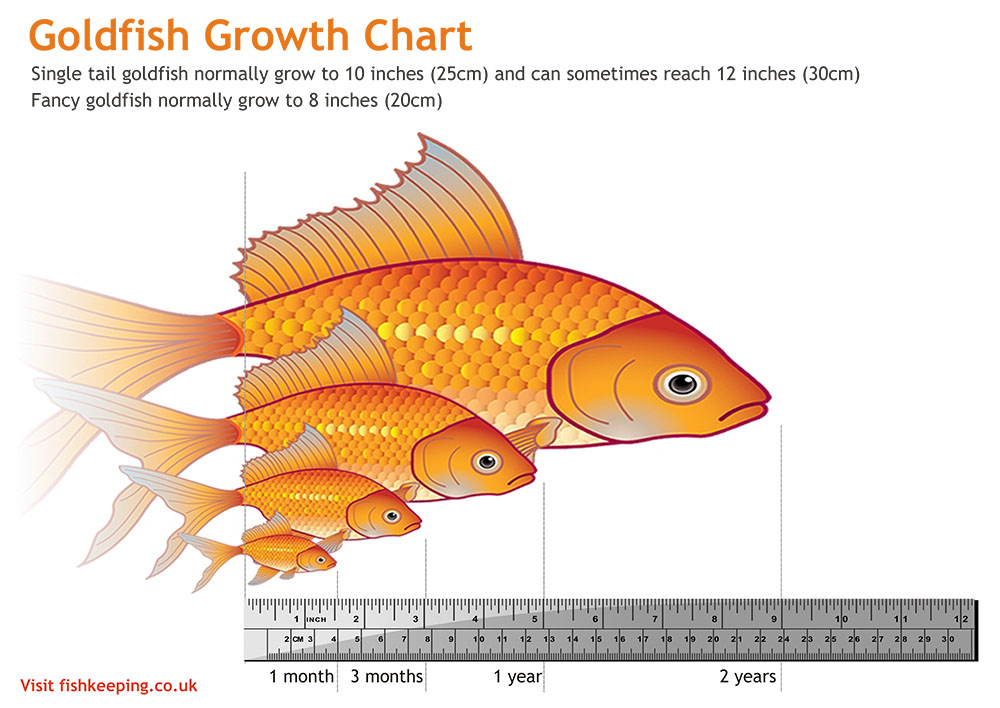
Goldfish need very large tanks, please have a read of our article on tank sizes for goldfish for more information. Think of the little goldfish you see in the shops as babies – your own child most likely started off in a Moses basket, then a crib or cot, then a toddler bed, then a single bed. The small tanks you find in a lot of shops are the equivalent of a Moses basket or cot – they are less expensive, but they can only be used for a few months. You can keep baby fish in them, but they will need a bigger tank very quickly, and you need to weigh up the pros and cons of having to buy several tanks, against buying just one that will be suitable for the full life of the goldfish.
Here is Howie the goldfish (who was won as a fairground prize in 2000 and now lives with one of Team INJAF) with his lady friend Rocket to show you what he thinks of the plastic fish bowls you see regularly in the shops:
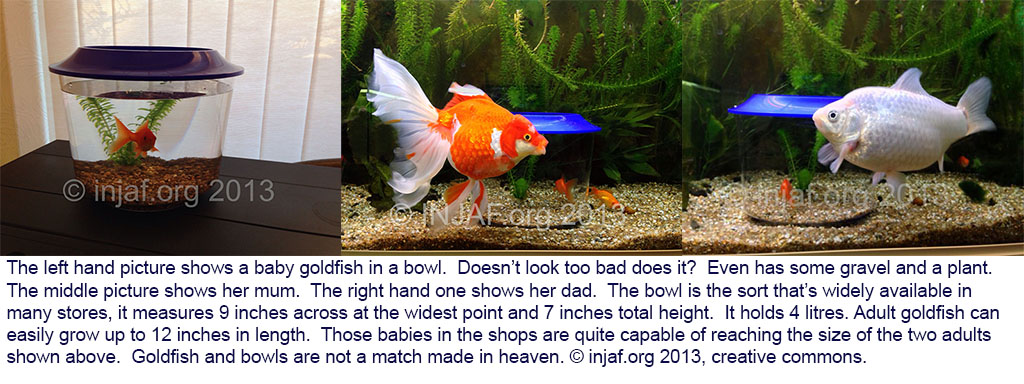
Goldfish also need a powerful filter to remove the significant amount of waste they produce (in the form of ammonia, which, if left in the water by an ineffective filter, will cause severe health issues, and a premature and unpleasant death for the fish).
They also require regular maintenance in the form of large weekly water changes and tank cleaning – they create a lot of poop that needs to be siphoned out of the gravel to keep the tank clean and healthy. All fish require maintenance, but some are easier to manage than others.
Please don’t be tempted to just try a goldfish in a bowl and see – you will end up with a poorly fish, then a dead fish, and an upset child. Replacing fish will teach your child that their pets are disposable/replaceable, and it will mean that they cannot form an attachment with their pet.
If you are capable of providing these majestic fish with the kind of home they need to thrive, then you will be well rewarded. If the care, space, time and financial outlay required sounds like too much of a commitment, then there are some fantastic alternatives to goldfish, which will provide your child with an equally positive and rewarding experience.
The following link gives a child-friendly and useful guide to the requirements of a goldfish:
Now the good news…
Ok, so hopefully now you are thinking that a goldfish might not be the most appropriate pet for your child. But if they would still like to have a wet pet, then there are lots of options to choose from.
First of all, ask yourself what you want your child to get out of having a tank
Do you want them to have a pet that they can name? Do you need a fish for each child? Would your child like a ‘team’ of fish perhaps? Do you want them to be able to decorate it with all their favourite characters (Peppa Pig, Spongebob Squarepants, Nemo etc.)? Do you want them to be able to learn about ecosystems and biodiversity? Biology and Chemistry? To help take responsibility for looking after a living animal? Having a fish tank can encompass any and all of these fascinating opportunities to engage and educate your child.
Before I go into the specific options there are a few basics which will apply to any tank – and they are really, really important – to make your life as easy and stress free as possible.
The Basics
All fish tanks must have a filter
This is possibly the most important message of the whole article and if you take nothing else away from it, please just take that. The reason why a filter is crucial is that fish produce ammonia as a waste product, and if it is allowed to build up in the water, it becomes toxic to the fish. Ammonia poisoning produces visible burns on the skin, can affect their gills and can easily kill the fish quickly if left to build up.
A filter works by removing ammonia from the water, therefore keeping the fish safe. It does this by providing a perfect home for a particular group of bacteria, who use ammonia as a food source and convert it in stages to a much less harmful product called nitrate. Nitrate can be kept to an acceptable level by performing moderate weekly water changes.
Without a filter, ammonia builds up to toxic levels VERY quickly, and to keep fish alive without a filter requires large daily water changes (i.e. lots of effort and time which, as a parent, may be in short supply!)
Please see our beginners guide to aquarium equipment for more information.
Choosing the right sized tank for your child’s set up
Tank size is a subjective decision for all fish keepers. There are some well-respected online databases and sources of fish information which we recommend. These provide tank size recommendations and care information for all the fish you will come across at the pet shop or garden centre:
- seriouslyfish.com (use the profile search box to look for species)
- fishtanksandponds.co.uk (use the search tab to find the species you’re looking for)
- fishkeeping.co.uk (use the search box or list of caresheet links on the right)
I would urge you to take on board the recommendations provided by these sites. Remember that the tank is this animal’s lifelong environment. You can’t open a door to let him out for a few hours: this is it for him, so it needs to be big enough to allow him to grow to his adult size and have room to swim and explore.
There are a lot of cheaper tanks and bowls on the market that are under 30 litres capacity. These tanks may seem like a bargain, but they are often more trouble than they are worth. It may seem like an extravagance to fork out for a larger tank, but the investment now will save you money in the long term as you will avoid having to buy fish medications, and replacements for fish that have died due to the physical stresses of being kept in an inappropriate tank.
Dechlorinator/water conditioner
Our tap water contains chlorine which is harmful both to your fish, and the helpful bacteria in your filter. Therefore you must use dechlorinator to treat any tap water that you add to the tank. When cleaning the filter, it is best to use tank water – never rinse filters in tap water as the chlorine will kill the bacteria.
Fishless cycling and getting the tank ready for your child’s fish
As mentioned above, the filter in a mature tank contains a healthy population of the bacteria which remove toxic waste from the water. The most humane way of growing this bacteria is to do a Fishless Cycle.
Basically this means that you will set up the tank, but instead of adding fish straight away, you will add small amounts of household ammonia (which can be bought for a couple of pounds at a hardware store) to provide a food source for the bacteria you want to grow. A fishless cycle usually takes over a month, but this could be reduced by asking at your pet shop or garden centre for a piece of their filter media. What you’ll get is a gunky bit of sponge, floss or ceramic “noodle”, but this will be covered in millions of the bacteria that you are trying to grow. If you put this media into your new filter, the bacteria will spread out over the filter and your tank will be ready for fish much quicker.
For a comprehensive guide to Fishless Cycling, please read our article on the nitrogen cycle, fishless cycling and getting your tank ready for fish.
The science involved in this process is pretty amazing and could be of interest to older children. Don’t worry, it’s not scary and while the tank is cycling your child can plan the layout, choose ornaments and read up about their new pet.
Choosing and buying fish for your child’s tank
There are lots of shops around that sell fish and fish related equipment, so it’s worth going to visit a few in your area to see which ones look good. It is definitely worth checking whether you have a dedicated Aquatics shop nearby. They tend to have better quality fish, and will normally be able to quarantine their fish before they go on sale so you are safe in the knowledge that your new pets are not sick before you buy them. Always choose fish that are brightly coloured, with round tummies and no kinks in their fins. It’s a good idea to observe the shop’s tanks for a while to see which individuals are most active and inquisitive – these are usually the healthiest specimens.
Now the necessities have been dealt with, it’s time to look at the fun stuff…
Fish your child can name – the individuals
Paradise Fish: Paradise fish (Macropodus opercularis) are absolutely stunning, and would make a perfect first fish for a child. They are colourful and easy to keep, they do not require a heater and a single fish can be kept in around 40-50 litres. They have a bit of a reputation in community aquaria as they can be aggressive to tank mates, but if kept alone they are relaxed and happy.
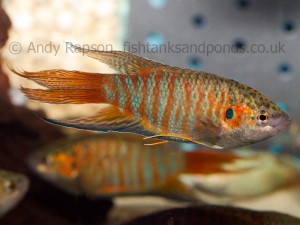
Siamese Fighting Fish: It’s undeniable that goldfish have personality. But they have a distant cousin who also packs a punch in that department, the Siamese Fighting Fish (Betta splendens). For the sake of adding a heater (which can cost as little as £7-10) you can keep one of these boys in a 30 litre tank (and it must be only one – they will fight if housed with another of the same kind).
They are not too fussy about décor, so will be happy to share their space with Dora the Explorer, pirate ships or Peppa Pig decorations. Just make sure there is nothing sharp that they could catch their fins on. They don’t like fast flowing water so a small filter is sufficient, and they prefer not to be blinded by strong lights, so some plants (real or silk) for shade would be a good addition and would give them somewhere to mooch about. They also like to laze around on plants when they’re having some chill out time! They come in a variety of colours and their fins are all shapes and sizes so your child can choose a fish that looks like a real individual!

Platies: Platies (Xiphophorus variatus) are very popular and make a good first fish for a child, as they are bold and bright, and easy to look after. You will need a heater to keep them, but the advantage of platies is that you can keep more than one together, for instance if your daughter wants an Anna AND an Elsa. In fact they are happier with some company, so it’s best to have more than one platy in your tank. They are again very happy to share a tank with Spongebob or Homer Simpson, so your child can enjoy choosing whatever decorations they like. Bear in mind that they will require a bigger tank, ideally 40-50 litres or more.
It is also important to buy just males, or just females, as they are the fishy equivalent of rabbits and will breed like mad if mixed together! Whilst this might seem appealing, it is an effort to feed and look after fry (baby fish), and there is also the problem of rehoming them when they are old enough.
It’s worth noting here that platies prefer hard water. You can check what kind of water you have by looking up your postcode on your water supplier’s website. If it turns out that your water is very soft, then it is not a problem, you can make your water suitable very easily by adding bicarbonate of soda. Use the link below to work out how much to add:
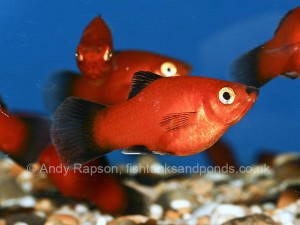
Fishy gangs that will appeal to children
Ember Tetra: Ember tetra (Hyphessobrycon amandae) look a little bit like miniature goldfish, and display some very interesting and amusing behaviour when kept in groups of around six or more. A heater is required, but due to their tiny size you could keep a group of them in 30-40 litres. For an older child, a group of these in a nicely planted tank with some bogwood would look like a slice of the Amazon, and provide that child with a good opportunity to watch the interaction of these sociable and active little fish in a natural environment.
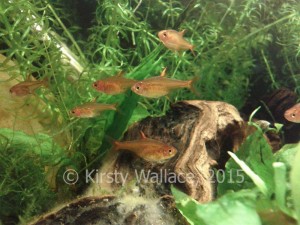
Endlers: Endlers (Poecilia wingei) are small and brightly coloured. The males are the most colourful and a group would be suitable for a smaller tank, you could keep a group in 30-40 litres with a heater to keep them warm. The males are generally well behaved and peaceful to each other, they do well kept in a species only tank due to their small size and easy going nature. It’s best to keep just males as they do like to breed! They are easy to look after and with the addition of some plants for them to play in they’d make a bright and lively set up for a child.
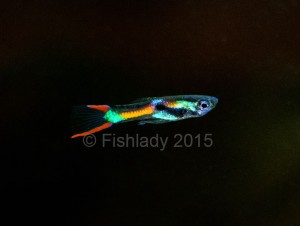
Cherry Barbs: Cherry barbs (Puntius titteya) are my favourite fish. They are easy to look after, and in groups of around six or more they are truly entertaining little characters. The males are red, and get redder when they are trying to impress a female, or see off another male (they are always doing one or the other). The females are yellow with a black stripe and will spawn regularly in the presence of males. As such there is always lots going on in a tank of cherry barbs! A group can be kept in a tank of around 50 litres. They need a heater and also some décor if possible to allow males to form territories.

Does it have to be a fish?
I have a four year old daughter and a two year old son, and they are just as interested in the invertebrates in my fishtank, as they are in the fish themselves. I have snails and shrimps, both of which breed easily (though this depends on the species) and are interesting to watch. My children like feeding fresh vegetables to the tank so that they can watch the shrimps and snails all come out for a feast, we count them, we look for momma shrimps holding big clutches of eggs, and we look for tiny baby snails and shrimplets.
Shrimps like very clean water. This means keeping nitrates a bit lower than is necessary for fish, and that is achieved by water changes. However this is not too much of a chore – if you have a shrimp-only tank it can be as small as 20 litres, and you can do a 10% water change a couple of times a week very easily with a large jug. They also like a mature tank. This means that the tank has had time to develop biofilm, which is basically a layer of microbes stuck to the surfaces inside the tank, which the shrimps can eat. It is worth introducing snails to the tank before adding shrimp, as they are great for building up biofilm in a tank.
The best website to discover just how many different and amazing invertebrates can be kept in your tanks is:
I will mention a couple of my favourite child friendly inverts below:
Pink Ramshorns can usually be found on Ebay and make an interesting addition to a girly tank. Ramshorns (which come in several colours) will breed freely in your tank and this can be helpful, because they will eat any extra fish food and stop it from polluting the water.
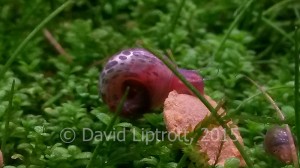
Batik Nerites are the bohemian hipsters of the snail world, they have an intricate tattooed appearance that may appeal to older children. They will not breed in your tank, as they require brackish (slightly salty) water to lay fertile eggs.

Bamboo shrimp love to sit in the flow of the filter outlet, they have large fans which they use to sieve the water for tiny bits of food. These shrimp are pretty mesmerising to watch and kids find them fascinating.
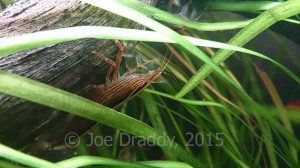
Cherry shrimp are bright and busy little creatures that are constantly on the go, picking at the décor and plants in a tank to find food. They breed very easily and children love to spot the tiny shrimplets. Add some oak leaves to your tank to provide shelter for shrimplets and encourage the growth of infusoria – microscopic animals that the shrimplets can feed on.
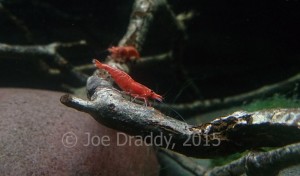
Tank related activities you can do with your children
For Little Ones….
As I mentioned earlier, small children love to watch what’s going on in a fish tank and there are lots of tank related activities which provide an opportunity to learn.
You can play simple counting games – see who can spot the most fish/shrimps/snails.
You can also let them help with feeding. Both fish and invertebrates enjoy a range of blanched vegetables, and it is fun to perform “experiments” to find out which foods the animals like best (just remember to remove anything that they haven’t eaten after a day or two).
Fish tanks are brilliant for “chill out”, or down time if a child is upset or stressed. Sitting in front of the tank with someone to talk about what they can see, can often diffuse tension and provide a good distraction if your little one is having a difficult moment and needs to calm down.
They can help to perform water changes. It is a good idea to siphon out old tank water into a bucket, and they can help by marking the tank with a Post-it or felt pen to indicate how far the water level needs to drop before it’s time to add the new water.
World Fish Migration Day has some fun and simple fish pictures for children to colour in, you can download them from the links below:
WFMD colouring picture 1
WFMD colouring picture 2
WFMD colouring picture 3
WFMD colouring picture 4
WFMD colouring picture 5
For Middle-sized Ones…
With a bit of research on your part, you can teach your child the scientific names of all the animals in your tank, as well as where they live in the wild, and other basic information.
If you are going for a natural looking tank, your children can help to find things to decorate it. Together you can collect branches and twigs (just make sure they are dead, and avoid evergreen trees as they contain harmful oils), and rocks and stones from your garden. If you find rocks and stones, this provides the opportunity for your child to perform an important experiment to check if they are safe to use in your tank – the vinegar test. Some rocks and stones are unsuitable because they will dissolve very slowly and alter the tank water over time. You can show your child how to identify these, by helping them to pour a few drops of vinegar on the stone: if it fizzes, then it is not safe for the tank. If it doesn’t fizz, then it’s good to go.
They may be able to help with measuring and mixing the dechlorinator – a very important job to help keep their pets healthy.
If your tank has plants in it and they get a bit jungly, your child can help with the “water gardening” by pinching off any overgrowth with their fingers, and taking out any dead or leggy stems.
You can make pictures of your tank and its inhabitants. By helping your child to look carefully at the animals and try to draw or paint them, you will be helping them to practice their observation skills.
For Big Ones…
Before buying your tank, older children can get involved in researching the fish they would like to keep, and their requirements. This can involve online research, and visiting shops and garden centres to see what appeals to the child. Have a read of our article about researching fishkeeping to see what sort of things you’ll need to find out about.
Fishless cycling is a long process, but with it comes the opportunity to engage an older child in some practical science. They can perform water tests, and keep a tank log to monitor the progress of the cycle, against the expected pattern of results. The arrival of “fish day” after doing a fishless cycle will be so much more exciting if your child has been fully engaged in the process leading up to it!
Tank maintenance can be performed by older children, and will help to teach them responsibility.
And finally …
I hope that this guide has given you some ideas for a tank which your child would enjoy, and which you would feel comfortable helping them to look after. The suggestions here are just suggestions, one of the best things you can do is get on to Google and start looking things up that interest you. Better yet is to join one of our recommended forums. They are full of people who have lots of ideas and experience, and who are on the forum because they want to help people like you make good decisions, for both your kids and your tank.
PS. Don’t forget the filter!
Further Reading:
Just starting out? Don’t buy a bowl! An article from Practical Fishkeeping, the best-selling fishkeeping magazine in the UK, about why to avoid fish bowls
Practical Water Chemistry: further information about how to (and whether to) alter the hardness of your water to suit your fish
Coral Reefs – Cities of the Sea: GrrlScientist talks about how her childhood fish tank inspired her to a career in sciences
Author: Kirsty Wallace
Photos and images courtesy of fishkeeping.co.uk, fishtanksandponds.co.uk, sharnbrookshrimp.co.uk, Joe Draddy, Fishlady, David Liptrott, and Kirsty Wallace
Thanks to all the people who helped Kirsty with advice and ideas, your input is much appreciated.




